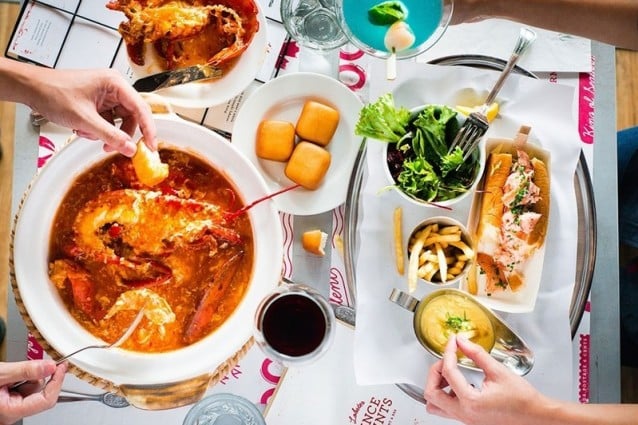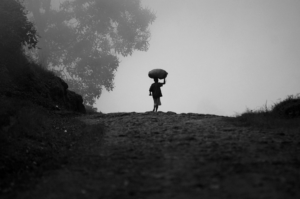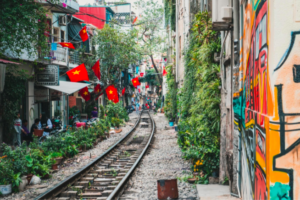ON THE SHARED nature of food, American chef and food writer James Beard said, “Food is our common ground, a universal experience.” I love the way that food, or more specifically, the sharing of food, has a unique way of bonding people, transcending all barriers, be they language, financial or cultural. While visiting museums and historic buildings can certainly help you understand a nation’s past, there’s something immediate and tangible about the insights a simple meal on the street can provide about how people actually live. Thankfully, you don’t have to be a foodie to appreciate how food can add an extra layer of adventure to your travels.
Markets
Travelers naturally gravitate towards the colors and vibrancy found in markets around the world. Some are very traveler-friendly, like the amazing La Boqueria in Barcelona where gregarious chefs make small talk as they prepare tapas or Istanbul’s Grand Bazaar where shopkeepers happily hand out samples of Turkish Delight or cups of apple tea. Vietnam’s markets? Not so much. Often due to the language barrier, but more likely because shopkeepers can’t be bothered with camera-toting tourists who obviously aren’t there to buy, it’s difficult to start any type of dialog despite there being so much to ask about: odd-looking fruits, unidentifiable animal parts and dried plants, to name a few. If you’re interested in markets, an easier way to access them is through cooking classes, many of which include a market tour. With a friendly guide mediating (and one who often has pre-existing relationships with the vendors), it’s much easier to ask questions and comfortably photograph. Some hotels will let you accompany the chef for free to the market as he makes his daily run, so don’t be afraid to ask.

Street food
In The Food Traveler’s Handbook, food writer Jodi Ettenberg says: “Food, mostly cheap food, became the way that I wanted to see a country, to understand how it moved and why people did what they did. I found food to be the most effective way to get a glimpse of the soul behind the façade. Street food was… the practical option available to everyone, tourists and locals alike.”
For the less adventurous who might feel lost sitting down to a meal where even ordering can be daunting, street food tours are a great way to sample new foods while learning about the culture. Barbara Adam of SaigonStreetEats.com says, “Unless you speak Vietnamese or have a [Vietnamese friend], it’s off-putting to be the only foreigner in a place, not knowing what to order or how to eat it.” While street food tours tend to be a little too packaged for me, I can definitely see the appeal for those who may be reticent to try unusual foods on their own. Sharing Meals Some of my favorite travel experiences have involved preparing and sharing home-cooked meals. I’ve been fortunate that friendly locals have taken me in for impromptu meals all over the globe, from a gregarious old metalsmith in Cairo to a family of fishermen in Kampong Chhnang, Cambodia.
If you’re only in a place for a few days and don’t speak the language, making those connections may be difficult. Thankfully, there are several organizations out there seeking to connect people through food.
Mealsharing.com, the culinary equivalent of couchsurfing, was designed as “a global community of people who get together, learn from each other, and share home cooked meals.” Getting its start as an underground movement in Chicago and Berlin, the meal sharing community which pairs hosts with guests, has grown into meals shared in hundreds of cities around the world. Founder Jay Savsani says, “Every time I meal share, it’s really exciting. What type of gift should I get? Where are my hosts from? You drive up to their home and there’s usually a 5-10 minute awkward period but the instant they bust out, “Oh, we have some appetizers and something to drink,” the awkwardness ceases. Meeting under the context of meal sharing, you’re attracting open-minded, kind people. We’re meeting in the context of something good.” Jay’s vision is for real people to connect over food. “The end goal is to have more and more locals host. It could be the grandson in Saigon who really wants to practice English and brings someone into the home with grandma’s cooking. Basically, meal sharing is an online platform to enhance your offline life.” While some meals are free, others have a pre-determined “chip in” amount, ranging from just enough to cover the ingredients to those who are aiming to make a supplementary income.
Another site that offers home-based eating experiences is WithLocals.com (available in Southeast Asia and the Netherlands). I’ve used them to connect with locals who take me to their favorite eateries, but also with people who host a home-cooked meal, often with family members around who don’t speak a word of English. It’s one thing to be invited into an expat home, but a totally eye-opening (and truly authentic) experience to climb up a narrow ladder to a common bedroom/living room/kitchen area which an entire family shares with a ceiling so low you can barely sit up straight.

In The Food Traveler’s Handbook, Jodi doles out advice for finding cheap eats around the globe. Part handbook, part travelogue, Jodi also features stories and tips from other travelers. Some of the advice is basic (eg. choosing stalls that are busy; avoiding vendors who cook and also handle money; eating seafood near the coast, etc.) but a lot of it is thought-provoking, even for the seasoned traveler. Some of my favorite tips include: using cough drops as an icebreaker for taxi drivers and then asking them where they ate lunch (not where they think tourists should eat); finding a midday meal at hospitals and universities, places known for having cheap food with high turnover rates hence fresher food; bringing along fruit (not sweets) to give to kids on long bus/ boat rides in developing countries as a way to start conversations with locals; and looking for places with families and older locals as customers (people with the most discerning tastes).
I asked Jodi about some of her more unique food experiences.
In your travels, which countries have you found to be the best/worst for cheap eats?
Cultures where street food is part of daily life have proven to be the best ― Vietnam, Thailand, and Laos among them. In Europe, cheap and fresh base ingredients are plentiful in Spain and Portugal, where it has been great to eat small tapas or lunch specials for very reasonable prices. And with a booming street cart culture in many US and Canadian cities, it’s become easier to eat cheaply… though still nowhere near as cheaply as Southeast Asia! It’s harder in places where location makes food expensive. Iceland was one of the hardest places to eat at reasonable prices, but the beautiful landscapes made it well worth it anyhow.
You talk about a “service swap” with vendors – being taught how to make a specific dish in return for bringing guests from the hostel back, teaching english to a spice seller in return for a lesson on spices. Do those suggestions really work? Those cooking spaces are awfully tight and the vendors are usually busy.
It certainly doesn’t work for every stall, that’s for sure. Most amenable is when I return a few times then ask to come early, as they’re setting up. When the stall is set up and customers haven’t yet trickled in is my golden hour for food learning. Less applicable for soups as these are often sitting for hours, but more for snacks and stir-fried meals. If it gets busy, of course I bow out.
What’s the best way to convince a fellow traveler to break out of their food comfort zone and try something new?
I think it’s about providing a space where they can trust you to guide them appropriately, be it in a long web piece (my Saigon Street Food Guide was written for that purpose!) or to take a tour that lets them explore food safely. After that, they’re usually emboldened to keep trying on their own.
How do you deal with food fatigue? isn’t it exhausting to always be searching out authentic food experiences instead of just giving in and having something from McDonald’s?
It doesn’t ever feel like fatigue. At no point am I saying “oh, if only I could just eat that burger!” I have celiac disease so it’s limiting to eat in life, in general. That’s my biggest stressor. Worst case I just go to the supermarket and cook up a meal ― not a bad “worst case” to have! But usually with help of excited readers, local vendors, and lots of questions, you can easily find your way toward a wonderful meal.
“The Food Traveler’s Handbook” is available at Amazon.com and also via Jodi’s site where you can also find her Saigon Street Food Guide.

GEAR REVIEW
CAFFLANO KLASSIC
While I’m all for trying new foods, some things require consistency, like a great cup of coffee. With the superb quality of beans available in Vietnam, there’s no reason your cup of joe should be anything less than extraordinary. but in talking to a trendy French restaurateur recently, we both laughed sheepishly to discover the other too often settled for the dreaded 3-in-1 instant coffee packs. So when I came across the Cafflano Klassic, a portable 470g all-in-one coffee maker that recently won the “2015 Best New Domestic Coffee Equipment” award from the Specialty Coffee Association of Europe and has been garnering buzz from the likes of Wired and GQ Magazine UK, I knew I had to try it.
The beauty of the Cafflano Klassic is in its simple yet good-looking design. What looks to be an insulated tumbler actually opens up into a ceramic foldaway hand-mill, a drip filter, a tumbler and a measuring cup. add beans and hot water, and you’re good to go. The hand grinder fits up to 30g of whole coffee beans and you can manually adjust the fineness of the grind. The grounds fall into a stainless filter dripper (no disposable pods, cups or paper filters to throw away, yay!) and the top acts as a measuring cup with a little hole as a spout. Hot water is meant to infuse the grounds for 30-45 seconds after which the rest of the water is poured in. Remove the filter and enjoy your cup of coffee in its own thermal mug. While I wasn’t sure if I’d enjoy the process of grinding my own beans or the time it took to do it, within days, I found the ritual to be soothing and the smell of freshly ground beans rather intoxicating. I’ve enjoyed incorporating making coffee into my morning routine. The coffee drips faster than the typical Vietnamese aluminum filters and I’ve scaled down the amount of water I use to get a richer taste (the tumbler is tantalizingly big at 15 ounces). The Cafflano Klassic is really well-made and feels solid in your hands (reflecting its rather high price point at USD99) and looks very sleek. The only thing I’d change is the lid, which perfectly sits on the top of the cup (used to pour hot water) and the tumbler (to keep the coffee hot), but which doesn’t actually screw onto the tumbler. The makers intended the coffee to be drunk immediately after grinding, so if you like your coffee on-the-go, you’ll just have to be careful with it. in all, though, the Cafflano Klassic is elegant in its simplicity and a drool-worthy addition to any coffee lover’s kitchen or carry-on.
Cafflano Klassic is currently available in 19 countries and is looking for distributors in Vietnam. In the meantime, order one in red or black from www.cafflano.com and check out “Cafflano” on Facebook for more user tips.






